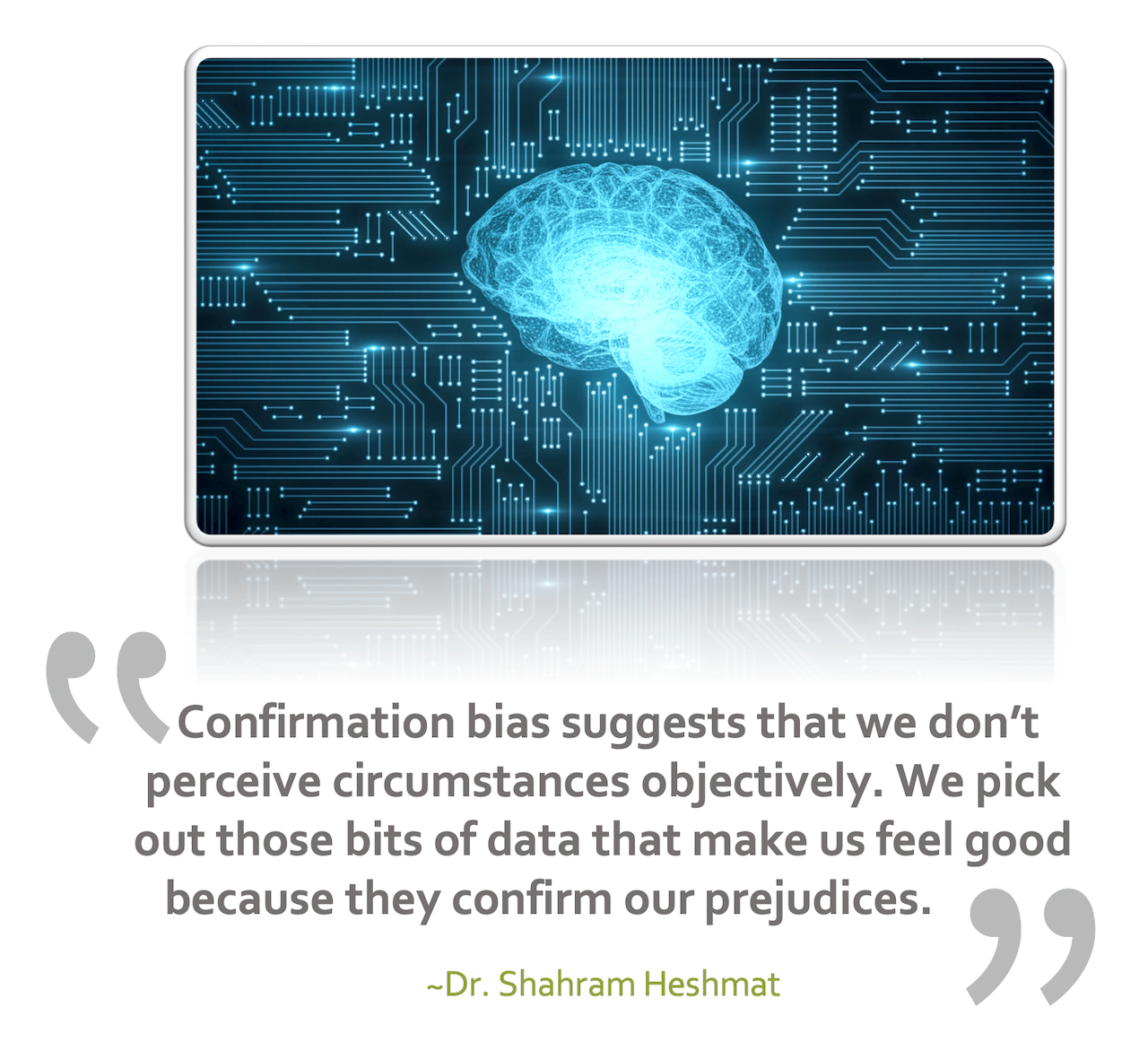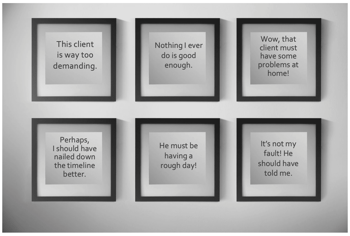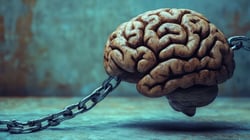Why should you care about cognitive biases?
Cognitive biases exert a powerful influence that often goes unnoticed, from how you communicate and build relationships to the choices you make in your personal and professional life. They silently shape everyday decision-making like a hidden puppeteer pulling your mind's strings.
If you're looking to expose your blind spots and for an excellent way to grow personally and professionally, try examining your cognitive biases?
Estimated reading time: 6 minutes
Heartmanity is proud to partner with outstanding companies that we wholeheartedly recommend so this post may contain affiliate links. You can read our full disclosure here.
|
Key Takeaways
|
In my transformative coaching sessions, my clients are often shocked at how cognitive biases and negative thinking patterns inhibit their happiness and growth. And what a tremendous shift happens when they start paying more attention.
There are three significant impacts on our lives. Left unchecked, cognitive biases can profoundly affect a person's life, hindering problem-solving abilities, compromising relationships, and distorting memories.
And this is an area that you can take charge of.
With these insights, you can reduce your susceptibility to the effects of cognitive bias. Unmask your blind spots and enhance your life personally and professionally!

What Is Cognitive Bias?
Cognitive bias refers to a consistent deviation from rational judgment influenced by fallible memory formation.
Human decision-making is hot-wired for shortcuts in our cognitive processes. When we deviate from rationality due to limitations, it is called a cognitive bias.
Biases influence our perceptions, how we process information, and how we shape our judgments, often unconsciously, causing errors and flawed decisions in daily life. For instance, the brain will use these biases as a shortcut to digest new information efficiently, relying on memories and experience rather than looking at a situation with adequate facts and critical thinking.
Let's first look at how our perspective is impacted by memories.
The Influence of Memory-Related Cognitive Biases
Our decision-making is deeply intertwined with our memories, yet cognitive biases often color our recollections and conclusions. A better understanding of the effects of these biases is crucial in our personal and professional lives.
The Weight of Recent or Vivid Memories
Recent or vivid memories have a strong, immediate presence in our minds due to their emotional intensity. This prominence can lead us to give these memories an undue emphasis, potentially overshadowing or overriding more pertinent but less memorable information. Such skewed accents can result in inaccurate judgments and decisions.
To counter the dulling of our conscious awareness, we can practice emotional intelligence skills—like mindfulness and reflection—to balance the impact of these memories.

Challenges of Unreliable Memory Formation
Memory reliability can falter, particularly under stress or complex situations. Our recall and interpretation of events are often shaped by preexisting beliefs and the context in which they occur.
Recognizing these biases can open our minds to out-of-the-box thinking and dramatically improve the quality of our decisions. Seeking diverse perspectives offers a broader view, helping us to evaluate situations holistically.
Questioning our initial impressions, considering alternative viewpoints, and staying open to new information are beneficial. Doing so encourages a more accurate, well-rounded approach to memory and inherent conclusions.
Why Self-Awareness Is the First Step in Overcoming Cognitive Bias
Cognitive biases distort our perception of reality, which prevent us from considering alternative viewpoints or making well-rounded decisions.
As with anything, without awareness, we are powerless.
Since so many biases are familial and societally influenced, they are silently masquerading without our knowing. The minute we have more understanding and knowledge about biases, our brains are alerted to formulate differently.
In addition, effort and self-awareness can reduce the impact of cognitive biases. By recognizing common biases and understanding their effects, we can develop strategies to mitigate (at least partially) their influence.
Understanding biases allows us to make more informed choices and minimize their negative impact on our actions, even though they may be impossible to eliminate altogether.
However, motivation is also required. Awareness alone rarely changes unhelpful habits and unconscious tendencies.
We must desire to be awake!
Now, we'll identify some common biases, which are prevalent in daily life.
Common Types of Biases
(with cognitive bias examples in real life)
Some claim there are over one hundred cognitive biases, even up to 180. Don't let that number overwhelm you, by becoming more mindful, you'll weaken their hold on you. We’ll explore a few to whet your inquiry and understanding.
Confirmation Bias
Confirmation bias refers to seeking information that confirms our preexisting beliefs and ignoring contradictory evidence. This bias prevents us from considering alternative perspectives and hinders our decision-making.
Example of Confirmation Bias:Some believe left-handed people are more creative than right-handed people. They then cite every creative left-handed person they meet as further proof while ignoring creative right-handed people.
Negativity Bias
The negativity bias causes us to rely on adverse events more readily than positive events. Our brains are programmed to ensure safety first. Therefore, threats, tragedies, and negative gossip tend to imprint more significantly than positive experiences or news.
Of course, it’s important to pay attention to threats for survival purposes, but it can be discouraging, even depressing if we only focus on the negative in the world. This type of bias also ties into loss aversion and catastrophic thinking patterns.
As Dr. Daniel Amen says, “The brain doesn’t do what’s good for it. The brain does what it has done.”
This is exactly why we want to develop daily mindfulness and watch for biases that are skewing our conclusions.
Example of Negativity Bias:A recent family vacation shows a great example of this negativity bias. Alaska Airlines is often our airline of choice. However, right before we were scheduled to fly out, an Alaska Boeing 737 had a door-sized section fly off right after take-off, requiring an emergency landing. This accident made us a tad nervous about flying. Fortunately, our long years of safe flights with Alaska and their thorough inspection of all their planes balanced our concerns.
Anchoring Bias
Anchoring bias is when we over-rely on the first piece of information we encounter when making decisions. This initial information, or anchor, can bias our subsequent judgments and prevent us from fully considering other relevant factors.
Example of Anchoring Bias:During negotiations, the first price offered for a car purchase serves as an 'anchor.' Even if the price is lowered later, the initial high price makes the reduced price seem more reasonable than if it were the first offer.
The Overconfidence Bias
Overconfidence is the tendency to overestimate our abilities and the accuracy of our judgments, leading to overly optimistic decisions or underestimated risks.
Example of Overconfidence Bias:A student overestimates their exam readiness based on self-assessment and underperforms, unaware they needed further study. Or they might base their need for study on a previous class or teacher who was more lenient in their grading, causing them to be less prepared.
The Bandwagon Bias
The bandwagon effect occurs when we align our beliefs or behaviors with those of a larger group simply because it is popular or socially accepted. This bias can lead us to make decisions without critically evaluating evidence or considering alternative viewpoints.
Social factors shape our beliefs and decisions. Social influence can introduce us to diverse perspectives and help overcome biases such as confirmation bias, but it can also amplify biases through the desire for social approval and conformity.
The balance of social influence and individual judgment is crucial.
Emotional intelligence aids in discerning when others overly influence our perceptions and when a balanced, objective assessment of the situation is made to guide conclusions and decision-making.
Example of Bandwagon Effect:
A person decides to follow a particular diet after seeing friends and celebrities endorse it on social media without researching its effectiveness or suitability for their health needs.
Work Example of Bandwagon Bias:
John, a marketing manager, often relies on his team's loudest opinions for campaign decisions, showing a susceptibility to groupthink (thinking or making decisions as a group in a way that discourages creativity or individual responsibility). He ignores quieter members with potentially innovative ideas. This bias restricts idea diversity and hampers his leadership and decision-making, possibly stalling his career progression.

Halo Bias
This bias is caused by our overall impression of a person, object, or brand, influencing our judgment of specific attributes or qualities associated with them. The halo effect can lead to biased evaluations and judgments based on superficial characteristics.
Example of the Halo Effect:An employee at work is always well-dressed and friendly—even charismatic. Their manager rates them high on their performance review, but the scoring is more about their appearance and charm than their actual work performance.
Fundamental Attribution Error
Fundamental attribution error is attributing others' behaviors more to their character and less to external factors. This bias can significantly affect relationships based on unrelated behavior, leading to misunderstandings, inadequate decisions, and ineffective communication.
Example of Fundamental Attribution Error:If a difficult colleague you don't get along with is late to a meeting, you might immediately think they're disorganized or don't care. This judgment overlooks possible external reasons for their tardiness like unexpected traffic or another previous meeting going too long. Such a quick decision can impact your future collaboration or the opinions of your team members.
Unmasking the influence of cognitive biases requires a deeper understanding of them and their impact on how we view the world and make decisions, even small ones. By recognizing these biases, we can strive for more rational and objective decisions and consider a broader range of information and perspectives.
The Role of Emotional Intelligence
Managing cognitive biases and making decisions heavily rely on Emotional Intelligence (EQ). It involves recognizing and understanding our emotions and those of others. Individuals with high EQ are more likely to be aware of biases and consider information that contradicts their own beliefs.
Studies have shown that emotional intelligence is linked to improved decision-making and problem-solving abilities. People with higher EQ levels display better decision-making even under stress.
This connection suggests that EQ could be valuable in contexts where cognitive biases are likely to occur, such as during complex interpersonal interactions or in the workplace.
Recognizing biases and developing emotional intelligence can lead to more nuanced and considerate social interactions and improve team dynamics at work. EQ also enhances our ability to navigate social dynamics, be empathetic and more willing to seek understanding of others.
Taking the time to develop your emotional intelligence further will pay significant dividends for future success.
If you’re ready to invest in raising your EQ quotient, check out this emotional intelligence mastery course.

The Bias Effect: 3 Ways Cognitive Bias Blocks Conscious Choice
Now, let's examine three eye-opening ways that cognitive biases can influence your decision-making process. Once you know the pitfalls, you'll be better equipped to spot them and respond with conscious awareness, which will help you grow personally and professionally.
Impact #1: Effect on Personal Growth and Self-Perception
Recognizing how our cognitive biases distort self-assessment is vital to overcoming them and achieving meaningful personal development.
Examples of Cognitive Biases Affecting Personal Growth
Self-Serving Bias and Personal Accountability:
The self-serving bias can significantly stall personal growth by causing us to attribute our successes to individual abilities and our failures to external factors. This bias makes it challenging to critically assess our own shortcomings. To learn from our mistakes, we need self-awareness and take responsibility for our actions and their impact, which are vital for personal development.
Real-life Example: David is an avid photographer. When his photos are complimented, he credits his natural eye for composition. However, when criticized, he blames the poor lighting or his camera's limitations, never considering that he might need to improve his skills or learn new techniques.
The Overconfidence Bias - Overestimating Abilities and Consequences:
Overestimating our abilities can lead to unrealistic self-assessments and overconfidence. When this bias is in play, we tend to take on overwhelming challenges, neglect necessary preparation, and be reluctant to seek help, impacting personal and professional growth.
Real-life Example: Confident in his coding skills, Alex takes on a complex software project without further preparation. He soon finds the project beyond his abilities, leading to missed deadlines and stress.
Impact #2: Influence on Interpersonal Relationships and Communication
Cognitive biases significantly influence interpersonal relationships and communication, often leading to misunderstandings and conflicts.
These mental shortcuts can distort understanding of others and impact interactions and perceptions. The distortion increases when intense emotions, such as anger, arise.
Examples of Cognitive Biases Affecting Relationships
Confirmation Bias:
Confirmation bias leads us to prioritize and believe information that aligns with our existing views about others and disregard evidence that contradicts our beliefs. This filter can skew our decisions and judgments about people.
Real-Life Example: Imagine a manager who values teambuilding highly but believes an employee isn't a team player. The manager notices and remembers only instances when the employee works alone or doesn't join team activities, ignoring times when the employee collaborates effectively with the team.
This bias impacts the manager’s decision to exclude the employee from collaborative projects, which may benefit from the employee’s input, but it also denies the employee the opportunity for advancement.
Fundamental Attribution: As you learned above, this bias causes us to attribute people's actions to their personality or character rather than situational factors, leading to misjudgments about behavior and affecting our interactions and communication.
Real-Life Personal Example: Your mother-in-law frequently stops by unannounced. Her visits are considered disrespectful and greatly annoy you and your spouse. Then, during your yearly visiting to their home, you may look for these intrusive behaviors unknowingly. However, your mother-in-law may only be trying to welcome you or be helpful. Due to prior experiences, the filter could create a false conclusion.
Real-Life Work Example: Consider a colleague who misses a deadline. You might quickly assume they missed it due to laziness or disorganization, overlooking external factors like a family emergency or heavy workload. This misjudgment might lead you to avoid collaborating with them on future projects, potentially causing you to miss out on their valuable skills and contributions.
Impact #3: Influence on Professional Decision-Making and Leadership
Cognitive biases significantly affect professional decision-making and leadership, impacting organizational efficiency, employee well-being, and success. Recognizing and mitigating these biases is imperative for creating fair, inclusive, and prosperous work environments.
Here are the more common ways cognitive biases show up in the workplace.
- Flawed Decision-Making: Cognitive biases can lead professionals to rely on incorrect information or make irrational judgments, which affects decision quality.
- Inhibition of Innovation: Biases can limit one's ability to think creatively, stifling innovation and the exploration of new ideas.
- Biased Employee Evaluations: Cognitive biases can cause unfair assessments of employees, impacting their satisfaction or career opportunities.
- Compromised Leadership: Leaders may inadvertently let biases sway decisions, potentially conflicting with the organization's values and employees' talents and abilities.
Examples of Cognitive Bias Affecting Work-Life
Fear of Losses Versus the Value of Gains: Behavioral economics research shows that people often prefer to avoid losses rather than pursue gains, a phenomenon known as loss aversion. This bias can lead to risk-averse behavior, overshadowing the potential benefits of positive opportunities.
Real-life Example: Emma, a project manager, hesitates to switch to a new, more efficient project management software despite its potential benefits. Instead, she concerns herself with risks such as data loss and her team's learning curve. Loss aversion influences this fixation on the “comfort of the known,” where the fear of losses outweighs potential gains and adversely impacts needed and timely decisions.Adaptability and agility are especially needed in today’s quickly changing tech world.
Problem Solving: Cognitive biases can negatively impact our careers by affecting problem-solving and decision-making. If biases cloud judgment, we might struggle to handle crises effectively or remember details accurately.
Additionally, being easily swayed by others' opinions or popular trends can prevent us from making independent choices.
Strategies to Overcome Cognitive Biases
Cultivating emotional intelligence is essential for effectively managing biases. Unmasking cognitive biases helps us navigate our choices more clearly and objectively.
As we increase our awareness of cognitive biases and their impact on our lives, the power and importance of emotional intelligence become clear. Several overall steps are helpful.
These steps include:
- Promote self-awareness and recognize personal biases.
- Seek out diverse viewpoints for a well-rounded view.
- Enter conflicts with openness to alternative perspectives.
Once you’ve gained more understanding, here are some strategies that can guide you in challenging yourself further:
 Promote Awareness through a Mindfulness Practice
Promote Awareness through a Mindfulness Practice
Begin by acknowledging that cognitive biases exist and can subtly influence our decisions.
Then, explore your thought processes and behavioral tendencies, become aware of your biases, and practice mindfulness.
By observing your thoughts and actions with a gentle, nonjudgmental awareness, your choices will be more insightful.
Exercise Skepticism and Rational Thinking
Cultivate a healthy skepticism towards your own assumptions.
Pause and reflect: Are you being too optimistic or pessimistic?
Rational thinking is our ally here.
Question your perspective.
This approach encourages us to step back, evaluate our thoughts critically, get greater clarity, and embrace a more balanced and grounded outlook.
 Practice Cognitive Reframing
Practice Cognitive Reframing
To help alleviate the effect of biases and better manage our emotional reactions, a simple practice that is extremely effective is cognitive reframing.
One excellent way to practice evaluating situations and experiences from varying perspectives is through this excellent little mind exercise below. It's simple but powerful!
Ask yourself, “What are six ways to view this experience, behavior, situation, or information?”
 Imagine six blank frames that you will fill in with different perspectives or ways of viewing an experience.
Imagine six blank frames that you will fill in with different perspectives or ways of viewing an experience.
This practice engages the frontal cortex, assists in stretching our mindset, and shifts us from autopilot to critical thinking.
When we frame our experiences more consciously, rather than reacting automatically, we are likely to find reasonable responses and more accurate conclusions.
When you first start out, you can write down six different conclusions, like in the examples below. As your skill develops, require yourself to write six more positive conclusions, which might take some practice.
Below are two situations and six different perspectives or ways of looking at them. The first framing exercise is a personal example, and the second is a work example.
PERSONAL EXAMPLE:
The situation: It's 2 o'clock in the morning and your partner isn't home and hasn't called. You're worried.
Notice that each perspective will invoke a different feeling and action.
When we step out of our normal responses and identify other possibilities, it's like shining a light on our common mental shortcuts that can lead us astray. This simple exercise enables us to navigate our emotional landscape with greater calmness, clarity, and understanding.
WORK EXAMPLE:
The situation: You just got off the phone from a difficult client meeting. The client yelled at you for missing a timeline on a project, even though they did not give you a deadline nor indicate that the work had a quick turnaround.
 In this work example, how we frame a client's (or manager's, employee's, or co-worker's) behaviors will impact how we respond. Pressing our reset button and looking at the person, behavior, or situation in different ways requires us to think differently and exposes possible biases that may be clouding our judgments, reactions, and conclusions.
In this work example, how we frame a client's (or manager's, employee's, or co-worker's) behaviors will impact how we respond. Pressing our reset button and looking at the person, behavior, or situation in different ways requires us to think differently and exposes possible biases that may be clouding our judgments, reactions, and conclusions.
Cognitive biases can profoundly impact our everyday lives, relationships, communication, and lives. By embracing the above strategies, we embark on a path of growth, not just in our personal lives but also in our professional spheres.
Closing Thoughts
We don't have to do this alone!
Using tools and seeking feedback can provide an external perspective, helping to balance our go-to biases. Whether it's leveraging technology or leaning on the wisdom of your community, these resources act as a mirror. Seeking a more objective view supporting more balanced decisions that are aligned with our values.
Overcoming cognitive biases isn't just about making better decisions; it's about becoming more aligned with our authentic selves and contributing more meaningfully to the world around us.
Check out Heartmanity's Emotional Intelligence Online Course today and take the first step towards a more emotionally intelligent, balanced, and empowered you.



.png?width=350&height=236&name=Personal%20example%20(1).png)








